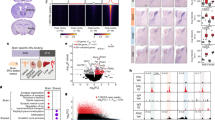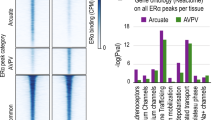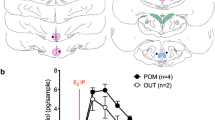Abstract
Genes induced by estrogens in the mammalian forebrain influence a variety of neural functions. Among them, reproductive behavior mechanisms are very well understood. Their functional genomics provide a theoretical paradigm for linking genes to neural circuits to behavior. We propose that estrogen-induced genes are organized in modules: Growth of hypothalamic neurons; Amplification of the estrogen effect by progesterone; Preparative behaviors; Permissive actions on sex behavior circuitry; and Synchronization of mating behavior with ovulation. These modules may represent mechanistic routes for CNS management of successful reproduction. Moreover, new microarray results add estrogen-dependent genes, including some expressed in glia, suggesting possible hormone-dependent neuronal/glial coordination.
This is a preview of subscription content, access via your institution
Access options
Subscribe to this journal
Receive 12 print issues and online access
$259.00 per year
only $21.58 per issue
Buy this article
- Purchase on Springer Link
- Instant access to full article PDF
Prices may be subject to local taxes which are calculated during checkout



Similar content being viewed by others
References
Pfaff DW . Drive: Neural and Molecular Mechanisms for Sexual Motivation. The MIT Press: Cambridge, MA, 1999.
Scully KM, Rosenfeld MG . Pituitary development: regulatory codes in mammalian organogenesis. Science 2002; 295: 2231–2235, in review.
Jensen EV, Jacobson HI . Basic guides to the mechanism of estrogen action. Recent Progr Horm Res 1962; 18: 387–414.
Walter P et al. Cloning of the human estrogen receptor cDNA. Proc Natl Acad Sci USA 1985; 82: 7889–7893.
Kuiper CG et al. Cloning of a novel receptor expressed in rat prostate and ovary. Proc Natl Acad Sci USA 1996; 93: 5925–5930.
Nilsson S, Gustafsson JA . Biological role of estrogen and estrogen receptors. Crit Rev Biochem Mol Biol 2002; 37: 1–28.
Shughrue PJ, Lane MV, Merchanthaler I . Comparative distribution of estrogen receptor alpha and beta RNA in the rat central nervous system. J Comp Neurol 1997; 388: 507–525.
Etgen AM In: Pfaff DW, Etgen A, Fahrbach S, Rubin R (eds). Estrogen Regulation of Neurotransmitter and Growth Factor Signaling in the Brain, in Hormones Brain and Behavior. Academic Press: New York, 2002 pp 381–440.
Kow L, Weesner G, Pfaff D . Alpha 1-adrenergic agonists act on the ventromedial hypothalamus to cause neuronal excitation and lordosis facilitation: electrophysiological and behavioral evidence. Brain Res 1992; 588: 237–245.
Petitti N, Karkanias GB, Etgen AM . Estradiol selectively regulates alpha 1B-noradrenergic receptors in the hypothalamus and preoptic area. J Neurosci 1992; 12: 3869–3876.
Kow LM et al. In vitro electro-pharmacological and autoradiographic analyses of muscarinic receptor subtypes in rat hypothalamic ventromedial nucleus: implications for cholinergic regulation of lordosis. Brain Res 1995; 694: 29–39.
Menard CS, Dohanich GP . Physostigmine facilitation of lordosis in naturally cycling female rats. Pharmacol Biochem Behav 1990; 36: 853–858.
Jones K et al. Steroid hormone regulation of ribosomal RNA in rat hypothalamus: early detection using in situ hybridization and precursor-product ribosomal DNA probes. J Neurosci 1990; 10: 1513–1521.
Cohen R, Chung S, Pfaff D . Alteration by estrogen of the nucleoli in nerve cells of the rat hypothalamus. Cell Tissue Res 1984; 235: 485–489.
Cohen R, Pfaff D . Ultrastructure of neurons in the ventromedial nucleus of the hypothalamus in ovariectomized rats with or without estrogen treatment. Cell Tissue Res 1981; 217: 451–470.
Woolley CS, Cohen RS . Sex steroids and neuronal growth in adulthood. In: Pfaff DW, Arnold A, Etgen A, Fahrbach S, Rubin R (eds) Hormones, Brain and Behavior. Academic Press: San Diego, CA, 2002 pp 717–777.
Frankfurt M . Gonadal steroids and neuronal plasticity: studies in the adult rat hypothalamus. Ann NY Acad Sci 1994; 743: 45–60.
Flanagan-Cato L . Estrogen-induced remodeling of hypothalamic neural circuitry. Front Neuroendocrinol 2000; 4: 309–329, review.
Flanagan-Cato LM, Calizo LH, Daniels D . The synaptic organization of VMH neurons that mediate the effects of estrogen on sexual behavior. Horm Behav 2001; 40: 178–182.
Carrer H, Aoki A . Ultrastructural changes in the hypothalamic ventromedial nucleus of ovariectomized rats after estrogen treatment. Brain Res 1982; 240: 221–233.
Pollio G et al. Antisense oligonucleotide blocks. Progesterone-induced lordosis behavior in ovariectomized rats. Mol Brain Res 1993; 19: 135–139.
Ogawa S et al. Effects of intrahypothalamic administration of antisense DNA for progesterone receptor mRNA on reproductive behavior and progesterone receptor immunoreactivity in female rat. J Neurosci 1994; 14: 1766–1774.
Mani SK et al. Inhibition of rat sexual behavior by antisense oligonucleotides to the progesterone receptor. Endocrinology 1994; 135: 1409–1414.
Lydon JP et al. Mice lacking progesterone receptor exhibit pleiotropic reproductive abnormalities. Genes Dev 1995; 9: 2266–2278.
Xu M et al. Regulation of hypothalamic neuropeptide Y1 receptor gene expression during the estrous cycle: role of progesterone receptors. Endocrinology 2000; 141: 3319–3327.
Brann DW, Chorich LP, Mahesh VB . Effects of progesterone on galanin mRNA levels in the hypothalamus and the pituitary: correlation with the gonadotrophin surge. Neuroendocrinology 1993; 58: 531–538.
Rossmanith WG et al. Induction of galanin mRNA in GNRH neurons by estradiol and its facilitation by progesterone. J Neuroendocrinol 1996; 8: 185–191.
Thomas A et al. The effects of progesterone on oxytocin mRNA levels in paraventricular nucleus of the female rat can be altered by the administration of Diazepam or RU486. J Neuroendocrinol 1999; 11: 137–144.
Cho BN et al. Progesterone stimulates GnRH gene expression in the hypothalamus of ovariectomized, estrogen treated adult rats. Brain Res 1994; 652: 177–180.
Petersen SL et al. Effects of estrogen and progesterone on luteinizing hormone-released hormone messenger ribonucleic acid levels: consideration of temporal and neuroanatomical variables. Endocrinology 1995; 136: 3604–3610.
Petersen SL, LaFlamme KD . Progesterone increases levels of mu-opioid receptor mRNA in the preoptic area and arcuate nucleus of ovariectomized, estradiol-treated female rats. Mol Brain Res 1997; 52: 32–37.
Petersen SL et al. Differential effects of estrogen and progesterone on levels of POMC mRNA levels in the arcuate nucleus: relationship to the timing of LH surge release. J Neuroendocrinol 1993; 5: 643–648.
Unda R, Brann DW, Mahesh VB . Progesterone suppression of glutamic acid decarboxylase (GAD67) mRNA levels in the preoptic area: correlation to luteinizing hormone surge. Neuroendocrinology 1995; 62: 562–570.
Gu G, Varoqueaux F, Simerly RB . Hormonal regulation of glutamate receptor gene expression in the anteroventral periventricular nucleus of the hypothalamus. J Neurosci 1999; 19: 3213–3222.
Arbogast LA, Voogt JL . Progesterone reverses the estradiol-induced decrease in tyrosine hydroxylase mRNA levels in the arcuate nucleus. Neuroendocrinology 1993; 58: 501–510.
Arbogast LA, Voogt JL . Progesterone suppresses tyrosine hydroxylase messenger ribonucleic acid levels in the arcuate nucleus on proestrus. Endocrinology 1994; 135: 343–350.
Moss R, McCann S . Induction of mating behavior in rats by luteinizing hormone-releasing factor. Science 1973; 181: 177–179.
Pfaff D . Luteinizing hormone releasing factor (LRF) potentiates lordosis behavior in hypophysectomized ovariectomized female rats. Science 1973; 182: 1148–1149.
Schwanzel-Fukuda M, Pfaff DW . Origin of luteinizing hormone-releasing hormone neurons. Nature 1989; 338: 161–164.
MacColl G, Quinton R, Bouloux PMG . GnRH neuronal development—insights into the mechanisms of hypogonadotropic hypogonadism. Trends Endocrinol Metab 2002; 13: 112–118.
Schwanzel-Fukuda M, Bick D, Pfaff DW . Luteinizing hormone releasing hormone (LHRH) expressing cells do not migrate normally in an inherited hypogonadal (Kallmann) syndrome. Mol Brain Res 1989; 6: 311–326.
Legouis R et al. The candidate gene for the X-linked Kallmann syndrome encodes a protein related to adhesion molecules. Cell 1991; 67: 423–435.
Ballabio A, Camerino G . The gene for X-linked Kallmann syndrom: a human neuronal migration defect. Curr Opin Genet Dev 1992; 2: 417–421.
Dellovade T et al. Anosmin-I immunoreactivity during embryogenesis in a primitive eutherian mammal. Dev Brain Res 2003; 140: 157–167.
Romano GJ et al. Estrogen increases proenkephalin messenger ribonucleic acid levels in the ventromedial hypothalamus of the rat. Mol Endocrinol 1988; 2: 1320–1328.
Zhu Y-S et al. Molecular analysis of estrogen induction of preproenkephalin gene expression and its modulation by thyroid hormones. Mol Brain Res 2001; 91: 23–33.
Priest CA, Eckersell CB, Micevych PE . Estrogen regulates preproenkephalin-A mRNA levels in the rat ventromedial nucleus: temporal and cellular aspects. Mol Brain Res 1995; 28: 251–262.
Vasudevan N et al. Crosstalk between oestrogen receptors and thyroid hormone receptor isoforms results in differential regulation of the preproenkephalin gene. J Neuroendocrinol 2001; 13: 779–790.
Bodnar R, Commons K, Pfaff D . Central Neural States Relating Sex and Pain. Johns Hopkins University Press: Baltimore, 2002.
Quinones-Jenab V et al. Estrogen regulation of mu-opioid receptor mRNA in the forerain of female rats. Mol Brain Res 1997; 47: 134–138.
Acosta-Martinez M, Etgen AM . Activation of mu-opioid receptors inhibits lordosis behavior in estrogen and progesterone-primed female rats. Horm Behav 2002; 41: 88–100.
Pfaus J, Pfaff D . m-, d- and k-opioid receptor agonists selectively modulate sexual behaviors in the female rat: differential dependence on progesterone. Horm Behav 1992; 26: 457–473.
Pfaus J, Gorzalka B . Opioids and sexual behavior. Neurosci Biobehav Rev 1987; 11: 1–34, review.
Pfaus JG, Gorzalka BB . Selective activation of opioid receptors differentially affects lordosis behavior in female rats. Peptides 1987; 8: 309–317.
McCarthy M et al. Behavioral effects of oxytocin: is there a unifying principle?. In: Jard S, Russell J (eds) Vasopressin, Colloque. NSERM/John Libbey Eurotext Ltd.: Paris, 1991 pp 195–212.
McCarthy MM et al. An anxiolytic action of oxytocin is enhanced by estrogen in the mouse. Physiol Behav 1996; 60: 1209–1215.
Nomura M et al. Estrogen receptor-beta regulates transcript levels for oxytocin and arginine vasopressin in the hypothalamic paraventricular nucleus of male mice. Brain Res Mol Brain Res 2002; 109: 84–94.
Krezel W et al. Increased anxiety and synaptic plasticity in estrogen receptor b-deficient mice. Proc Natl Acad Sci USA 2001; 98: 12278–12282.
Insel T, Young L . Neuropeptides and the evolution of social behavior. Curr Opin Neurobiol 2000; 10: 784–789, review.
Ferguson J, Young L, Insel T . The neuroendocrine basis of social recognition. Front Neuroendocrinol 2002; 2: 200–224, review.
Ferguson J et al. Oxytocin in the medial amygdala is essential for social recognition in the mouse. J Neurosci 2001; 21: 8278–8285.
Choleris E et al. An estrogen dependent 4-gene micronet regulating social recognition: a study with oxytocin- and estrogen receptor alpha and beta-knockout mice. Proc Natl Acad Sci USA 2003; 100: 6192–6197.
Nomura M, Durback L, Chan J, Gustafsson J-A, Smithies O, Korach KS et al. Genotype/age interactions on aggressive behavior in gonadally intact estrogen receptor b knockout (bERKO) male mice. Horm Behav 2002; 41: 288–296.
Beuckmann C et al. Cellular localization of lipocalin-type prostaglandin D synthase (beta-trace) in the central nervous system of the adult rat. J Comp Neurol 2000; 428: 62–78.
Nilsson S et al. Mechanisms of estrogen action. Physiol Rev 2001; 81: 1535–1565, review.
Swanson LW, Sawchenko PE . Hypothalamic integration: organization of the paraventricular and supraoptic nuclei. Annu Rev Neurosci 1983; 6: 269–324.
DeKloet E et al. Estradiol modulates density of putative ‘oxytocin receptors’ in discrete rat brain regions. Neuroendocrinology 1986; 44: 415–421.
Newman SW . The medial extended amygdala in male reproductive behavior: a node in the mammalian social behavior network. Ann NY Acad Sci 1999; 877: 242–257.
Keverne EB . Pheromones, vomeronasal function, and gender-specific behavior. Cell 2002; 108: 735–738, review.
Keverne E . The vomeronasal organ. Science 1999; 286: 716–720.
Brennan PA, Schellinck HM, Keverne EB . Patterns of expression of the immediate-early gene egr-1 in the accessory olfactory bulb of female mice exposed to pheromonal constituents of male urine. Neuroscience 1999; 90: 1463–1470.
Mong JA et al. Estradiol regulation of lipocalin-type prostaglandin D synthase transcript levels in the rodent brain: evidence from high density oligonucleotide arrays and in situ hybridization. Proc Natl Acad Sci USA 2003; 100: 318–323.
Urade Y, Hayaishi O . Prostaglandin D2 and sleep regulation. Biochim Biophys Acta 1999; 1436: 606–615.
Wahlestedt C et al. Potent and nontoxic antisense oligonucleotides containing locked nucleic acids. Proc Natl Acad Sci USA 2000; 97: 5633–5638.
Kia SH, Mong JA, Pfaff D . Estradiol (E2) up-regulation of glutamine synthetase (GS) mRNA in the medical basal hypothalamus (MBH) and amygdala: implications for glia in hormonal modulation of neuronal function. Soc Neurosci 2002 abstract.
Kia SHK, Yuen G, Krebs CJ, Pfaff DW . Co-expression of NMDA receptors and estrogen α mRNAS in the mouse brain. Mol Brain Res 2002; 104: 47–54.
Watanabe T et al. NMDA receptor type 2D gene as target for estrogen receptor in the brain. Brain Res Mol Brain Res 1999; 63: 375–379.
Mansky T, Wuttke W . Glutamate in hypothalamic and limbic structures of diestrous, proestrous, ovariectomized and ovariectomized estrogen-treated rats. Neurosci Lett 1983; 38: 51–56.
van den Pol AN, Trombley PQ . Glutamate neurons in hypothalamus regulate excitatory transmission. J Neurosci 1993; 13: 2829–2836.
Luine VN, Grattan DR, Selmanoff M . Gonadal hormones alter hypothalamic GABA and glutamate levels. Brain Res 1997; 747: 165–168.
Csaki A et al. Localization of putative glutamatergic/aspartatergic neurons projecting to the supraoptic nucleus area of the rat hypothalamus. Eur J Neurosci 2002; 16: 55–68.
Mong J, Nunez JL, McCarthy MM . GABA mediates steroid-induced astrocyte differentiation in the neonatal rat hypothalamus. J Neuroendocrinol 2002; 14: 45–55.
Mong JA, Glaser E, McCarthy M . Gonadal steroids promote glial differentiation and alter neuronal morphology in the developing hypothalamus in a regionally specific manner. J Neurosci 1999; 19: 1464–1472.
Theodosis D . Oxytocin-secreting neurons: a physiological model of morphological neuronal and glial plasticity in the adult hypothalamus. Front Neuroendocrinol 2002; 23: 101–135, review.
Hartwell LH et al. From molecular to modular cell biology. Nature 1999; 402(Suppl): C47–C52.
Reed R, Maniatis T . An extensive network of coupling among gene expression machines. Nature 2002; 416: 499–506.
Ravasz E et al. Hierarchical organization of modularity in metabolic network. Science 2002; 297: 1551–1555.
Acknowledgements
This work was supported by NIH grant HD-05751. Illustrations were created by Par Parekh.
Author information
Authors and Affiliations
Corresponding author
Rights and permissions
About this article
Cite this article
Mong, J., Pfaff, D. Hormonal symphony: steroid orchestration of gene modules for sociosexual behaviors. Mol Psychiatry 9, 550–556 (2004). https://doi.org/10.1038/sj.mp.4001493
Received:
Revised:
Accepted:
Published:
Issue Date:
DOI: https://doi.org/10.1038/sj.mp.4001493
Keywords
This article is cited by
-
Synchronization of the Estrous Cycle against the Background of Increased Excitability in Rats Selected for Catatonic Type of Reaction
Bulletin of Experimental Biology and Medicine (2015)
-
Gene expression patterns in four brain areas associate with quantitative measure of estrous behavior in dairy cows
BMC Genomics (2011)
-
Estrogen evokes a rapid effect on intracellular calcium in neurons characterized by calcium oscillations in the arcuate nucleus
Endocrine (2007)



